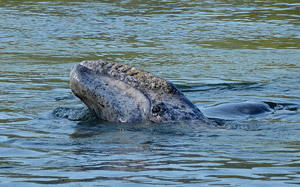For those following the saga of the 45-foot-long, 60 - 80,000 pound gray whale refusing to leave the Klamath River, where she's been hanging out in full view of sightseers and other whale-wishers gawking from a Highway 101 bridge -- looks like no new bright ideas have emerged to shoo her away. The latest attempt, yesterday -- blasting sounds of killer whales, her No. 1 predator -- was a no-go. From the Eureka Times-Standard today:
After the latest attempt to get the whale to leave the river failed, scientists are taking a wait-and-see approach to the situation, said Sarah Wilkin, stranding coordinator with the National Oceanic and Atmospheric Association. They will continue to monitor the whale, and attempts to intervene have been stopped, she said.
”We'll just kind of take it day by day,” Wilkin said.

The whale was initially accompanied upstream by her calf, who has not been seen since Saturday and seems to have cut the cord for good. Stranding Coordinator Wilkin told the Times-Standard, "In the days before it left, it started spending time away from the mom and it seemed like that time was increasing up until the point where it just left entirely. Once weaning is done, the moms and calves don't hang out socially."
On Tuesday, KQED News intern Nick Fountain talked to Dave Hillemeier, the Fisheries Program Manager of the Yurok Tribe, about the unsuccessful efforts made last weekend to try to scare the whale downstream.
"On Sunday we had a coordinated effort between multiple agencies," Hillemeir said, "including the National Marine Fisheries Service, Humboldt State University, Del Norte County Sheriff's department, California Department of Fish and Game, the Yurok tribe. Del Norte County actually had a fire boat down here.
"We started approaching the whale with pipes hanging over the boats, banging on the pipes... It was not all that successful. So we'd try various tactics of hazing to try to make the whale believe it wasn't the best place to be, where we'd have various boats approach her... We did that for most of the day...but she just didn't seem to be affected by it that much."